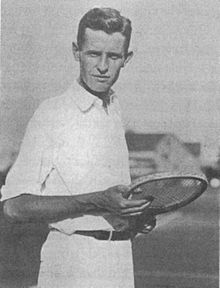Robert Lindley Murray
 |
|
| Country (sports) |
|
|---|---|
| Born |
November 3, 1893 San Francisco, CA, United States |
| Died | January 17, 1970 (aged 77) Lewiston Heights, New York |
| Height | 1.88 m (6 ft 2 in) |
| Turned pro | 1913 (amateur tour) |
| Retired | 1926 (played part-time afterwards) |
| Plays | Left-handed (1-handed backhand) |
| Int. Tennis HoF | 1958 (member page) |
| Singles | |
| Highest ranking | No. 2 (1917, Karoly Mazak) |
| Grand Slam Singles results | |
| US Open | W (1917, 1918) |
| Professional majors | |
| US Pro | SF (1933) |
Robert Lindley Murray (November 3, 1893 – January 17, 1970) was an award-winning chemist and an American male tennis player.
Robert Lindley Murray was born in San Francisco, California, United States to Augustus Taber Murray and Nellie Howland Gifford. He graduated from Stanford in 1913 with a degree in chemistry and received a chemical engineering master's degree the following year. Murray played for the varsity team and became the 1913 Pacific Coast intercollegiate champion.
In June 1914 Murray won the New York Metropolitan title defeating Fred Alexander in the final in five hard-fought sets and in August he won the coveted Meadow Club Cup, at Southampton, NY, beating Watson Washburn in the final in three straight sets.
Murray won his first national tennis title in February 1916 when he became the singles champion at the U.S. National Indoor Tennis Championships, played at the Seventh Regiment Armory in New York. In the final he defeated Alrick Man in three sets 6–2, 6–2, 9–7.
He won the U.S. National Championship men's singles title in 1917 and 1918. The tournaments were renamed National Patriotic Tournaments in support of the war effort. No trophies were handed out to the winners and the entrance fees were dedicated to the Red Cross. In 1917 Murray defeated Bostonian Nathaniel W. Niles in four sets. Murray did not intend to play the 1918 National Patriotic Tournament as his skills as chemical engineer were considered too important for him to play during wartime. Only after a lengthy effort to persuade him by the president of his company, Elon Hooker, did Murray finally consent to play. Despite little preparation he managed to reach the final in which he faced Bill Tilden, the future seven-time champion. In an impressive performance Murray easily defeated Tilden in three sets 6–3, 6–1, 7–5.
In the USLTA national rankings, he was the U.S. No. 1 in 1918, and was ranked fourth in 1914, 1916 and 1919. He was ranked the World No. 2 for 1917 by Karoly Mazak.
...
Wikipedia
